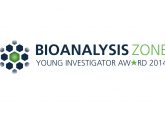2014 Young Investigator Finalist: Adam Shuhendler

Nominee:
Nominated By:
Supporting Comments:
What made you choose a career in bioanalysis?
From my graduate training in pharmaceutical sciences, I became aware of critical gaps in biomedicine regarding the development of safe and effective therapeutic strategies, as well as in the clinical implementation of existing therapeutics. It quickly became apparent that these gaps could be closed through the combination of chemistry, biology, and medical biophysics; an interdisciplinary approach that is a fundamental tenet of bioanalysis as a discipline. Bioanalysis as a career was the best fit for my strategy of improving therapy development and implementation through in vivo molecular imaging of active biochemical targets necessary to effect change in medical therapeutics.
Describe the main highlights of your bioanalytical research, and its importance to the bioanalytical community.
The ability to specifically and selectively report on targeted effectors of biological processes in health and disease drives bioanalysis. My research is focused on designing novel molecular imaging probes to identify the activity of important effector biomolecules in vivo. One major group of such effectors for which I have developed probes is reactive oxygen and nitrogen species (RONS). RONS are key signaling molecules that underlie the etiology of a majority of inflammatory and disease processes, including cancer, arthritis, neuropathology, and ageing, and key mechanistic mediators of metabolism-associated drug toxicity. RONS are difficult to detect in vivo and have not adequately been detected in whole, living systems due to their high reactivity and short half-lives, which limit their distance of diffusion from their sites of production. With my work in bioanalysis, a range of molecular imaging probes sensitive to various RONS have been successfully developed across optical and photoacoustic modalities for the in vivo and real-time monitoring of RONS in aberrant physiology. These probes have opened up new avenues for bioanalytical investigations of RONS with a fidelity that has not previously been achievable in vivo, and for the first time, have applied molecular imaging to drug toxicity screening in live animals.
Describe the most difficult challenge you have encountered in the laboratory and how you overcame it.
The most difficult challenge I have faced in designing molecular imaging probes for in vivo and in situ bioanalysis is finding the right materials from which to construct the nanosensors that satisfy key requirements. In addition to biocompatibility, sensitivity, and target specificity, and since the target for these probes are highly oxidative RONS, it was paramount that the nanoprobe materials resisted oxidation and maintained their emissive properties in order to ensure true radiometric fluorescence in vivo imaging. Finally, since the goal was bioanalysis in living animals, near-infrared emission from the material was necessary. A failure of the nanoprobe material to satisfy any of these requirements would have led to failure of the bioanalytical probe. This challenge, which was fundamental to nanoprobe success, was overcome with the integration of semiconducting polymers into the nanoprobe design: biocompatible, near-infrared emitting materials with excellent resistance to RONS-induced chemical oxidation. The combination of these robust polymers with RONS sensing moieties has provided the foundation for the successful investigation of RONS in vivo, extending bioanalysis previously limited to in vitro applications into the whole living animal.
Where do you see your career in bioanalysis taking you?
My career in bioanalysis will take me to new frontiers of “seeing” into living things, with the ultimate destination of applying the bioanalytical probes I design to humans. Through academic avenues, I will mentor and educate future bioanalytical scientists on molecular imaging probe design. Coupled with commercialization and clinical translation, I see my career also involving the innovation of novel in vivo bioanalytical techniques for medical diagnosis and the improvement of therapeutic outcomes for an array of diseases. Of particular importance to me in my career is the pursuit of RONS imaging in humans in order to both answer fundamental questions of the chemical biology of these key subcellular signaling and effector molecules, as well as to empower medical practice with the ability to “see” RONS production in a patient with high temporal and spatial resolution for the diagnosis and monitoring of disease onset and remediation. I see my career in bioanalysis providing unprecedented tools for the assay of key biomolecules in living subjects, ultimately to enhance the clinical practice of medicine.
How do you envisage the field of bioanalysis evolving in the future?
Our global community of scientists is uncovering fundamental aspects of biology, chemistry, and physics. While this continuously and exponentially expands our knowledge, it also exposes current gaps in our understanding. However, at the same time it provides innovations in materials and instrumentation with which to seal these gaps. This will be key for bioanalytical techniques, as bioanalytical scientists will be tasked with searching out these novel materials and technologies, and to apply them in unique ways. I believe bioanalysis will make two major leaps forward in the future: (1) high fidelity and rapid whole pan-omic analysis from patient blood samples for diagnosis of disease and monitoring of therapy response; (2) high spatial and temporal resolution molecular imaging techniques predicated upon novel “smart” imaging probes responsive to small molecule or enzyme targets pertinent to disease onset, progression, or remediation. Bioanalytical techniques that have changed the way biological samples are analyzed (i.e. microfluidics, electrophoresis, etc.), and imaging technologies that allow us to see into living things are well out of their infancy and are primed with knowledge and experience. This is why I believe that this combination of innovative ex vivo and in vivo bioanalytical techniques will drive the future of bioanalysis.
Please list 5 of your recent publications, and select one that best highlights your career to date in the field of bioanalysis.
1. Shuhendler AJ*, Pu KY*, Cui L, Uetrecht JP, Rao J. Real-time, two-channel imaging of drug-induced hepatic oxidative and nitrosative stress with nanosensors. Nature Biotechnology DOI:10.1038/nbt.2838 (2014) (Epub ahead of print).
*Authors contributed equally to this work
2. Pu KY*, Shuhendler AJ*, Jokerst JV et al. Semiconducting polymer nanoparticles as photoacoustic molecular imaging probes in living mice. Nature Nanotechnology 9, 233–239 (2014).
*Authors contributed equally to this work
3. Ye D*, Shuhendler AJ*, Cui L et al. Bioorthogonal cyclization and in situ self-assembly of small molecule probes for imaging caspase activity in living mice. Nature Chemistry DOI:10.1038/nchem.1920 (2014) (Epub ahead of print).
*Authors contributed equally to this work
4. Pu KY*, Shuhendler AJ*, Rao J. Semiconducting polymer nanoprobe for in vivo imaging of reactive oxygen and nitrogen species. Angew Chemie Int Ed. 52(39), 10325–10329 (2013).
*Authors contributed equally to this work
5. Shuhendler AJ, Staruch R, Oakden W et al. Thermally-triggered ‘off-on-off’ response of gadolinium-hydrogel-lipid hybrid nanoparticles defines a customizable temperature window for non-invasive magnetic resonance imaging thermometry. J Control Release. 157(3), 478–484 (2011).
First choice: Shuhendler AJ*, Pu KY*, Cui L, Uetrecht JP, Rao J. Real-time, two-channel imaging of drug-induced hepatic oxidative and nitrosative stress with nanosensors. Nature Biotechnology DOI:10.1038/nbt.2838 (2014) (Epub ahead of print).
Reasoning: Drug development and pharmacotherapeutics form treatments of the majority of diseases today, yet our ability to directly assay drug toxicity in real-time has been limited to in vitro or ex vivo methods with inadequate reliability. I have designed a nanosensor for simultaneous and differential detection of two mechanistic mediators of drug-induced hepatotoxicity. For the first time, drug hepatotoxicity can be monitored in real-time in living animals, innovating bioanalytical techniques for molecular toxicology and drug development.





